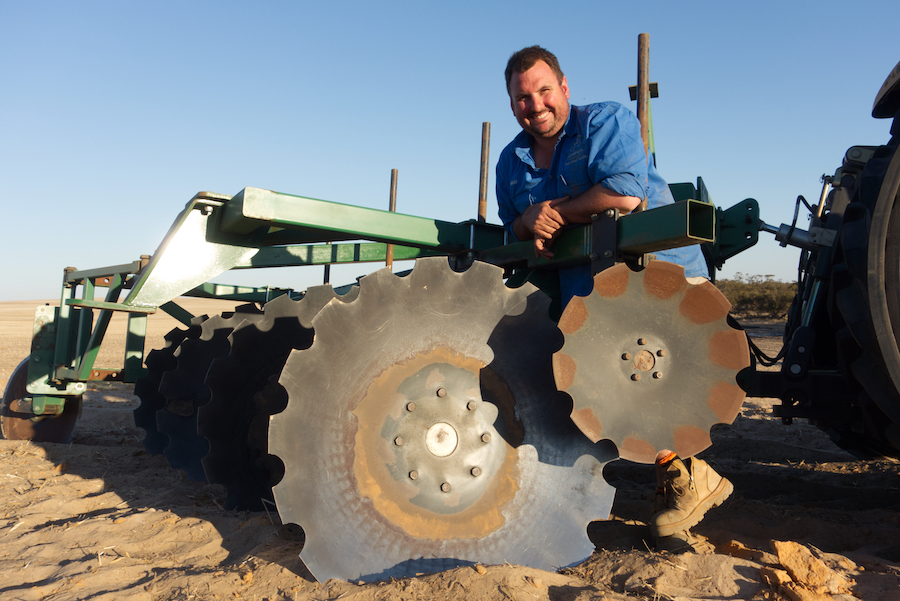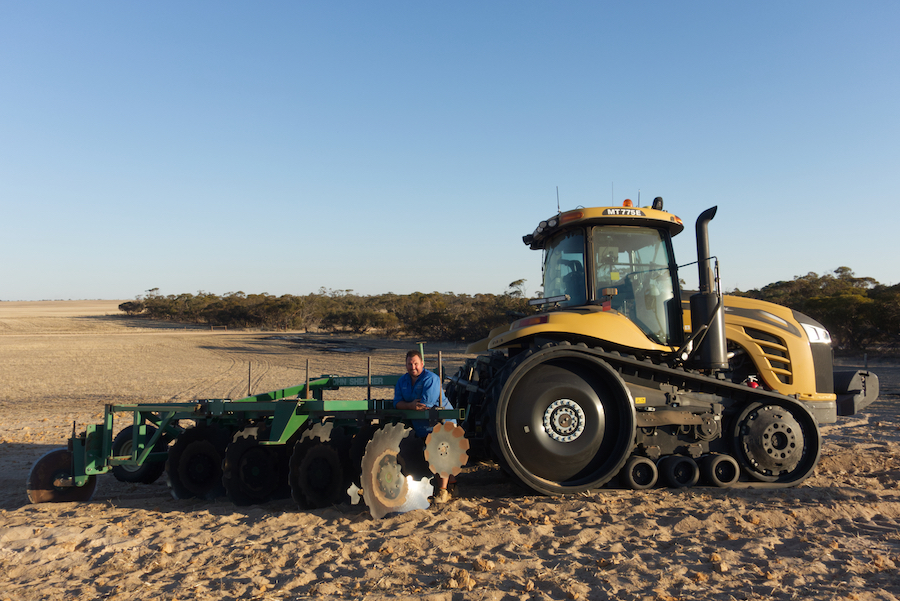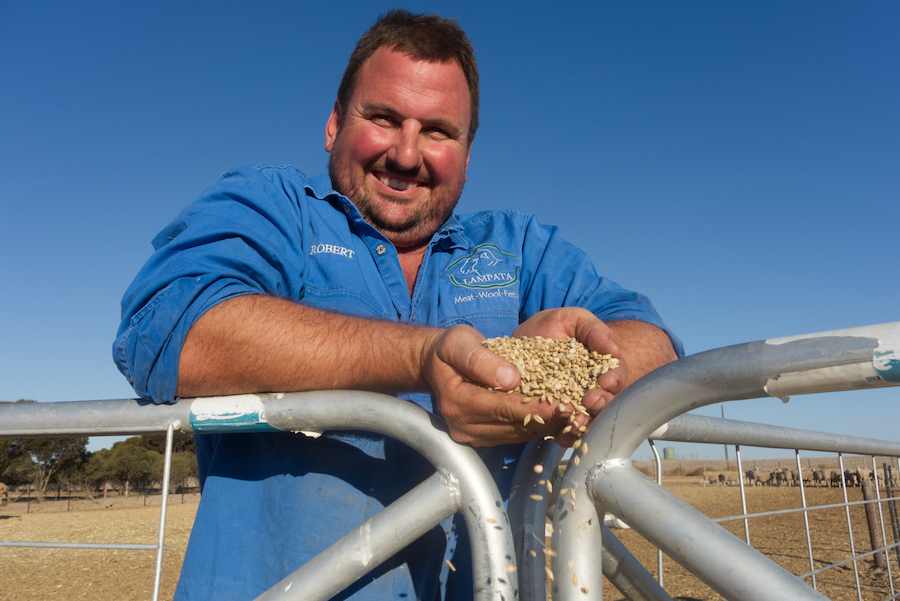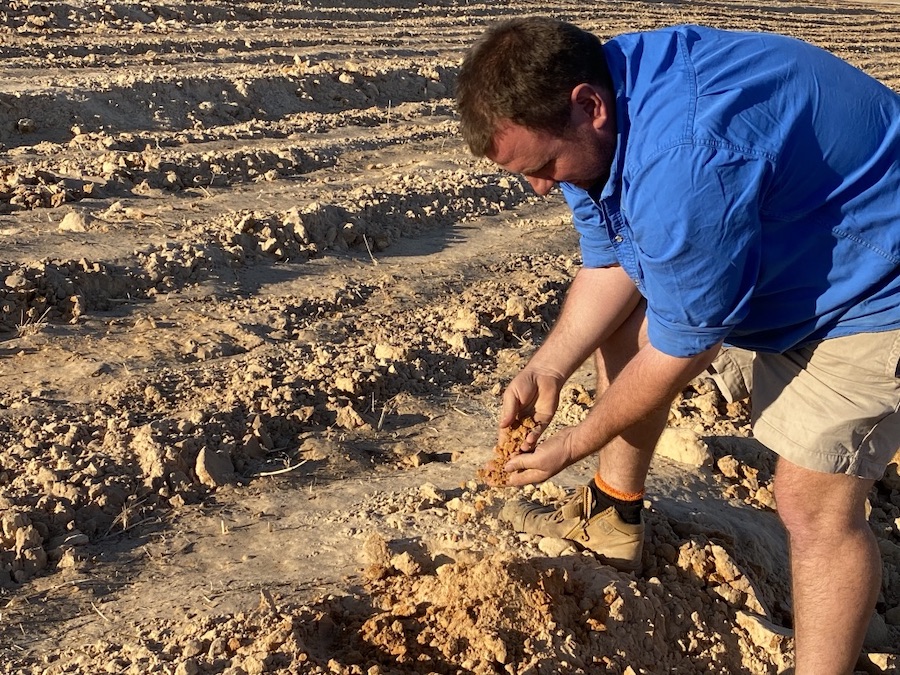It was a research and development dream come true when South Australian grower Rob Pocock saw a prototype ‘high-work-rate’ plough machine put to the test on his 3400-hectare property at Lameroo in the Mallee region.
Rob, a fourth-generation grower and former chair of Mallee Sustainable Farming (MSF), came up with the basic concept for the soil amelioration machine, which has since revved into reality through collaborative research from 2018–20.
The machine was developed as part of GRDC-invested research led by MSF in partnership with the University of South Australia and Adelaide-based machinery manufacturer John Shearer.
The result is a ‘high-work-rate’ soil inversion disc plough built to simultaneously ameliorate non-wetting sands and sow crops in a single machinery pass.
When GroundCover™ visited Rob’s farm, University of South Australia research engineer Dr Chris Saunders was performance testing its soil-mixing capabilities on a delved paddock featuring a problematic sandy rise.
There, the paddock test showed the machine can bury and mix underperforming sands deep into the duplex soil profile, comprising sand over clay.
Grand design
For Rob, its capacity for “complete burial of non-wetting surface sands” is an important function that ultimately aims to improve soil structure by mixing the topsoil that constrains crop productivity with the underlying clay subsoil.
The ability to remodel the soil profile composition is expected to provide a suite of long-term soil health and vitality benefits. For instance, increases in soil moisture infiltration, water-holding capacity, organic matter content, microorganism activity and, in turn, improved crop germination and yield potential.
Dr Saunders says the machine’s ability to restructure the soil by mixing the two soil types together depends on whether the soil inversion disc plough can access the clay subsoil layer.
Paddock testing showed the prototype machine buried non-wetting sands to a soil depth of 40 centimetres. Below this depth, clay subsoils are beyond the machine’s working limit. “The testing also showed it brought heavier subsoils to the paddock surface,” Dr Saunders says.
“The new machine is an alternative to clay spreading only where clay occurs at soil depths of 30 to 40cm,” Dr Saunders says. “It can be used more extensively as a cost-effective alternative to inversion mouldboard ploughing and spading machines.”
To this end, Rob says, “it can be set up for both inversion ploughing and spading, meaning it combines the functionality of two machines in one.

Rob Pocock came up with the basic concept for a soil inversion disc plough built to simultaneously ameliorate non-wetting sands and sow crops in a single machinery pass. Photo: Clarisa Collis
“For instance, skimmer discs can be installed to completely invert the weed seedbank accumulated on the sandy topsoil deep into the soil profile as a mouldboard ploughing alternative, or the disc angles can be adjusted to deep-mix soil as a spading alternative.”
Soil inversion disc ploughing, using old modified plough technology, has attracted significant interest from growers, especially in low-rainfall areas, mainly as a low-cost approach to spading and mouldboard ploughing.
Rob says the paddock test highlighted that the machine’s cost-benefits mainly stem from its fast operational speed and reduced maintenance costs, particularly compared to spading machines.
For example, the tractor-towed ‘plough and sow’ machine can operate at 10 kilometres per hour, whereas a tractor-towed spading machine averages about 5–6km/h.
However, Rob says it also has potential to be used on country that has not been delved or clay spread (where the clay layers are less than 40cm deep) to ameliorate non-wetting sands with just one machinery pass.
“That capability would be a game changer,” he says.
“My original concept was for a machine that could compete with the functionality of the Plozza Plow but travel faster and operate at greater soil depth.” (Plozza Plows are typically John Shearer or Chamberlain one-way disc plough machines fitted with large notched and dish-shaped discs made by Ben and Sean Plozza from Eneabba, Western Australia.)
“The basic idea being that a high-work-rate disc plough could get over more hectares to ameliorate non-wetting sands rapidly.
“Even if the process had to be repeated, using the new machine, every 10 years, it would still be a cost-effective option compared with clay-spreading earthworks.
“In areas where the discs can lift shallow clay layers beneath the sandy topsoil to the soil surface, we may not have to clay spread.”
In other situations where deep clay is out of reach, however, Rob envisages the prototype machine could be used to complement delving and clay spreading earthworks, with the aim of mixing clay and sand through the soil profile.
Earthwork effects
After using steel rollers to level and smooth the soil surface for sowing and trafficability, Rob was able to quickly establish Compass barley on the disc-ploughed paddock area.
Reflecting on the benefits of the amelioration works in a drought-affected, low-rainfall growing season, he says the barley crop “looks remarkably good”. Rob’s farm in the SA Mallee region has seen its lowest rainfall on record over the past five years from 2017–21.
He estimates that the barley crop on the paddock area where the machine was tested is more than twice as productive as the untreated paddock area. “The effect on crop production really surprised me,” Rob says.
The yield potential of barley growing on the machine-mixed soil is about 2.5 tonnes per hectare, compared with about 0.8t/ha on the untreated soil.
“It was positive and unexpected to see this yield benefit in a drought year following major disruption to the soil.”
The yield lift was unexpected in such dry conditions because the delving followed by ploughing had aerated the soil – and consequently removed moisture – to a soil depth of about 60cm, he says.
Rob now plans to further test the machine’s soil-mixing capabilities, as well as its seeding component, on 40ha of non-wetting sands in the 2022 season.
The prototype has the option of a two-metre-wide tow-behind modified seeding unit that enables growers to establish ground cover on erosion-prone soils in a one-pass operation as part of the amelioration works.
“We would already be driving over that paddock area, so it makes sense to be sowing a crop at the same time if we can.”
Amelioration intensifies

Rob plans to use the prototype machine as part of a long-term program for amelioration earthworks targeting 400ha of non-wetting sands on his Mallee property. Photo: Clarisa Collis
Development of a prototype ‘plough and sow’ machine has, in part, provided the impetus for South Australian grower Rob Pocock to step up his Lameroo farm’s soil amelioration program.
Rob plans to use the new machine for non-wetting surface sand burial and incorporation with shallow clay layers, in combination with selective delving and clay-spreading works, as part of an incremental, long-term strategy.
Rob now aims to ameliorate a minimum of 40 hectares a year for the next 10 years, targeting 400ha of non-wetting surface sands on the 3400ha property he farms with his wife Courtney and his parents Bruce and Gaye.
This signals a major shift in the family’s commitment to amelioration earthworks. In the past five years, for example, the Pococks have ameliorated about 40ha of underperforming sands with delving and clay-spreading operations.
Rob says the decision to expand the family’s amelioration program was influenced by access to the new machine, but also increasing land values in the Lameroo district, where the farm is spread across six properties.
“Increased land prices have made the amelioration earthworks a more appealing proposition,” Rob says.
The spike in farmland prices also means we have to invest in soil improvement to lift the productivity of every hectare we have.
“About 400ha of cropping country requires amelioration. But we have another 200 to 300ha of non-wetting sands on larger farm areas that are better suited to perennial pastures than the amelioration earthworks.”
In addition to water-repellent sands, he says, the intensified earthworks program also aims to remediate heavy clay flats and small areas of land degradation, known as ‘Mallee seeps’. This pattern of land degradation manifests as bare patches of unproductive cropping country prone to waterlogging, scalding and high salt concentration on the soil surface.
Rob plans to use deep ripping and spreading operations to incorporate sand into heavy clay flats, plus delving and clay spreading to improve sandy soil structure adjacent to seep-affected areas.
He is also considering using the ‘plough and sow’ machine to lift soil fertility by incorporating organic compost, spread on the paddock surface, into the soil profile.
Holistic program

A new 4000-head sheep feedlot helps to optimise soil performance on the Pocock family’s mixed farm. Photo: Clarisa Collis
Mechanised amelioration earthworks are one strand of a holistic effort to lift soil performance on Rob Pocock’s mixed farm in the South Australian Mallee region.
Rob’s overarching strategy weaves together diverse on-farm practices and principles, geared to improve the productivity of the dune swale soils that underpin the profitability of his cropping program and sheep enterprise.
In addition to machine-based works, this suite of tactics integrates controlled-traffic farming (CTF), precision seeding, wetting agent applications, perennial pastures and a new feedlot.
In the past five years, Rob has invested in new machinery to facilitate the transition to a CTF system, in which the widths of farm machinery are matched to three-metre permanent wheel tracks.
The system comprises a 12m-wide harvester and seeder and a 36m-wide sprayer and spreader.
Rob says the only “compromise” was dual wheels on the harvester. Although wider than the 3m tracks, these provide important traction on wet sands while reducing compaction by spreading the machine load over four wheels instead of two.
The main objective of CTF conversion was to reduce soil compaction and protect fragile surface sands by limiting heavy machinery to permanent wheel tracks.
To this end, CTF implementation has minimised soil compaction which, in turn, has increased crop root growth, enhancing plant access to soil moisture and nutrition on non-wetting sands.
Crop access to stored soil moisture, especially summer rainfall, is critical on Rob’s Lameroo property where annual rainfall averages 340 millimetres.
However, the benefits of permanent wheel tracks are not limited to the cropping gains that stem from reduced soil compaction.
He reports that CTF has also improved whole-farm and paddock layout. This has secured machinery efficiency gains, notably fuel savings, as well as real-time kinematic (RTK) global navigation satellite systems with two-centimetre accuracy to guide machinery on permanent tracks.
Tactical sowing

Rob relies on a range of sowing tactics to boost crop performance on his Mallee dune swale soils. Photo: Tanya Morgan, Mallee Sustainable Farming
Accurate machine guidance facilitates another strand of the Pococks’ strategy to boost soil performance: precision farming practices, such as inter-row and edge-row sowing.
Edge-row sowing, in particular, helps overcome soil-derived yield constraints because the crop is precision-seeded directly beside or on the edge of the previous year’s plant rows, without disturbing its stubble.
This means seeds are placed in a soil moisture zone with immediate access to residual nutrients and root pathways created by the previous crop, which significantly reduces the non-wetting effects of surface sands and increases yield potential.
The Pococks also tackle non-wetting sands at sowing by applying wetting agents with the seed in-furrow to promote crop germination. For Rob, this is part of an insurance strategy in seasons when there is not enough rain to wet up sandy soils, but enough rain for the crop to establish when wetting agents are applied.
Pastures spread across 1100ha of the family’s 3400ha property aim to boost the overall resilience of the farming system through building organic matter and plant-available nutrients in the soil.
Boosting soil organic matter with a pasture phase is important for improving soil structure and nutrient storage needed for crop growth. Studies show soil organic matter can decline substantially on continuously cropped areas compared with pastured areas.
He says annual medic pastures are mainly grown as a break crop on cropping paddocks, while perennial lucerne and veldt grass are grown on less-productive country for sheep grazing and to remediate large areas of water-repellent sands.
Plus, the family has established a 4000-head feedlot for their 1900 self-replacing Poll Merino ewes. The new feedlot for sheep containment allows the Pococks to reduce grazing pressure and promote ground cover on erosion-prone soils during summer.
More information: Rob Pocock, 0438 824 758, robert@lampata.com; Chris Saunders, 0419 752 292, chris.saunders@unisa.edu.au; Tanya Morgan, 0429 395 918, tanja.morgan@msfp.org.au; Mallee Sustainable Farming - High Work Rate Plough
Read: Multi-function amelioration concept revs into reality.

























































